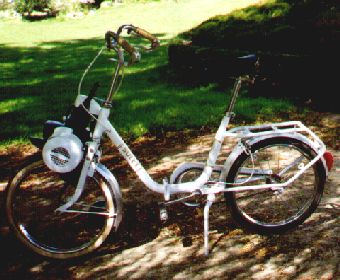 Go
to the Archive index
Go
to the Archive indexThis is a story of two very different Solex models. The first consists of the battered remains of a 5000 that was bought for a few francs as part of a deal to obtain a fairly complete 330 for rebuilding. The second is a Solex bicycle rescued from a Council Tip.
During 1967 SINFAC decided to enter the cycle market and signed a contract with the Italian firm of Bianchi. The series produced was comprehensive ranging from children’s cycles to out and out racing models. The range became available in France and Germany from January 1968.
The bicycle, which is the one involved in this project, is of a type very common in the sixties and seventies. Produced by a number of manufacturers both in England and on the Continent and commonly known as a “shopping bike” it comprises a single, large diameter tube hinged just forward of the bottom bracket so that it can be conveniently folded and placed in the boot of a car. Wheels of sixteen inches diameter are fitted. I found my example, which was in reasonable condition and complete except for the chain guard, on the rubbish tip where I was depositing some garden waste. Thinking that it would be ideal for the grandchildren to ride around the garden when they visit us I rescued it from the crusher and took it home where it remained in my garage for several months.
I had decided that the remains of the 5000 were too far gone to merit a rebuild but, as the wheels were the same diameter as those of the Solex cycle, I began to think of the possibility of fitting a Solex motor to said cycle. The forks of the 5000 were in good condition and comparing the forks of the two machines I realised that, if the length of the thread on the forks from the 5000 was increased by three quarters of an inch it would be compatible with the headstock of the bicycle.

This operation was carried out by Jean-Pierre in return for a bottle of Côtes du Rhone and the cycle parts reassembled. As yet I have been unable to obtain a serviceable set of tyres for the 5000 wheels and so the bicycle wheels and tyres have been pressed into service after making suitable spacers to enable the narrower cycle wheel to be positioned in the 5000 fork. Together with the freshly sand blasted and painted frame and the white wall tyres the whole thing looks very smart. Slight corrosion was removed from the alloy mudguards which polished up very well. To complete the cycle parts a chain guard of unknown origin was adapted to suit. A motor from a 3800 was built up with new rings, pump membrane and gaskets. The ignition coil was checked and a brand new condenser fitted to eliminate a possible source of trouble. Controls and brakes were all connected up and we were ready for the off.
How does it perform? It really flies. Being considerably lighter than a standard Solex the difference is quite noticeable. Braking leaves something to be desired as the rear calliper cycle brake is inadequate in spite of the use of larger brake blocks from a VTT. However, when the rear wheel from the 5000 with its drum brake is fitted this should change. Also, because of the comparatively narrow bicycle tyres, the ride is somewhat harder than one expects from a normal Solex. Given time for the motor to settle down and the rings to bed in I confidently expect a maximum speed in the region of 30mph.
Registering this hybrid in the UK would inevitably mean a ‘Q’ plate although both the motor and cycle parts are of Solex origin. The motor number 4653289 dates from 1968 and the cycle, which does not carry a frame number, is certainly post 1968. Therefore I would argue that it is a 1968 VéloSoleX. Fortunately I won’t have that problem here.
Am I pleased? I certainly am. I expect that it has all been done before so please don’t spoil my day by writing and telling me that it has. To any Ami who has a mind to build something different go ahead and try it. It is quite simple and you’ll have a lot of fun and something out of the ordinary for the next year’s events.
First published - December 1999